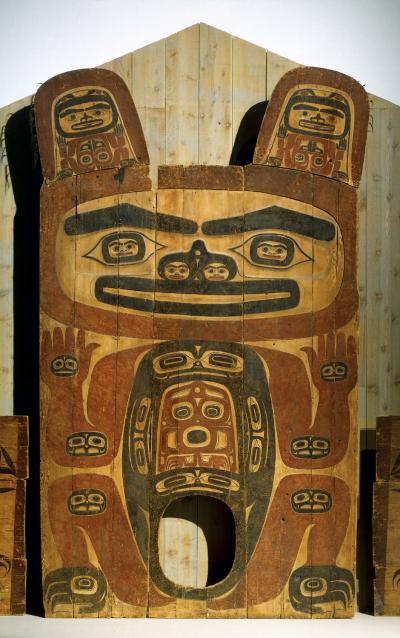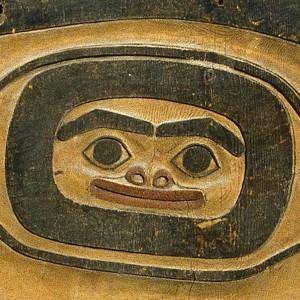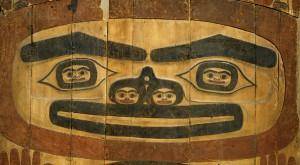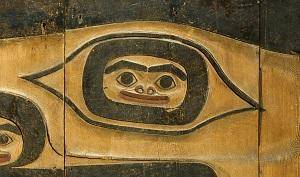
House Partition with Shakes Family Crest
Artist not known, Tlingit
About 1840
15 ft. X 9 ft.
Native arts department acquisition funds, 1951.315
Photograph © Denver Art Museum 2008. All Rights Reserved.
This partition comes from the house of Chief Shakes of Wrangell, Alaska, who belonged to the Nanyaayi clan of the Tlingit tribe. The Tlingit lived in groups or villages along the Pacific Coast of what is now southern Alaska and northern British Columbia. Each child was born into one of two groups, called moieties. Within each moiety, there were several smaller groups called clans. The Tlingit were skilled artisans and master woodcarvers, known for their elaborate totem poles, bentwood boxes, and canoes. They had extensive trade contacts and dealt in many different types of goods, which were made by their own tribe as well as others. Animals played an important role in the Tlingit belief system. The Tlingit believed that animals and humans were closely related and that every animal had a soul. They also believed that an animal could take on the form of a human, as is evident in many of their stories. Some stories involve animals and humans changing from one species to the other, while others tell of animals and humans living together and sometimes marrying one another. Even though the Tlingit people had to rely upon hunting and fishing for survival, no animal was ever killed needlessly. Hunters followed strict rituals and asked for forgiveness at the end of the hunt, thanking the animal for giving its life.
Screens like this one were used in large wooden houses to separate the clan leader’s sleeping area from the central areas of the house. Clan houses were large and there could be up to six families living in each one. Screens fronting the sleeping quarters of nobility were painted with important family crests, which are symbols used to represent individual families. The clan leader would enter and exit the room through the hole in the center of the crest—a symbol of rebirth from his ancestors. Sometimes the screens were removed to open up the space for ceremonies. In front of these private rooms was a platform where the owner and his family sat. The image of the brown bear represents the crest of the Shakes family, which memorializes a clan myth in which two brown bears escaped death in a flood by climbing a mountain. The Indians killed one of the bears and took its head and skin to wear as a family crest during festivals. In another clan story, during the time when animals and humans were believed to have married, a male ancestor is said to have been captured by bears and forced to marry the female bear. Having managed to escape, he kept the bear symbol as a clan symbol.
Details

Faces
Faces appear at the joints, eyes, nostrils, and hands of the bear. The small bear figures inside the ears distinguish the crest of the Shakes family from other groups within the clan.

Formline
The formline delineates each of the forms. Usually the formline is painted in black; however, this screen’s formline is red.

Ovoid & U Forms
These are the building blocks of Northwest Coast art. Ovoid is the most common shape—a kind of rounded rectangle. This shape is used to form the face, eyes, and small faces that appear at the joints. U forms are usually thick on one end, thinner on the other.

Low Relief
The screen was carved in low relief, meaning that the design projects only slightly from the surface of the wood; it is not three-dimensional. The design was then painted with red and black, which are fairly traditional colors.
More Resources
The Tlingit are Matrilineal
In this video, a Tlingit woman from the Kukhhittan clan discusses the matrilineal organization of the Tlingit.
Tlingit Indian History of Southeast Alaska
Joe Williams, Tlingit Indian and former mayor of Ketchikan, Alaska, explains Tlingit matrilineal organization and the Eagle and Raven clans in this video.
Websites
Listening to Our Ancestors
This online exhibition from the National Museum of the American Indian has an interactive map of Native life along the North Pacific coast. Its online gallery shows some a broad array of artworks from the area.
Wacky Kids: Northwest Coast Indian Carving
This interactive family website has fun activities, resources and other information. The site features other Northwest Coast carvings, and there are also other DAM objects to explore!
Northwest Coast Indian Shapes
This handout shows typical Northwest Coast Indian shapes.
Alaska Native Heritage Center Website
The Alaska Native Heritage Center’s website provides detailed information about Tlingit culture.
Smithsonian Museum of Natural History
Find more information about Tlingit culture from the Smithsonian Museum of Natural History.
Books
Stewart, Hilary. Looking at Indian Art of the Northwest Coast. Seattle: University of Washington Press, 1979.
An exploration of the basic form and function of the lines, shapes and colors used in Northwest art and the similarities between the various cultures along the Pacific Coast.
Reid, William. The Raven Steals the Light. Seattle: University of Washington Press, 1996.
A collection of ten stories from the Northwest Coast Indians, including Bear Mother. Appropriate for ages 4-8, but a great resource regardless of age.
Children's Books
Goldin, Barbara Diamond. Coyote and the Fire Stick. San Diego: Harcourt Books, 1996.
An illustrated tale of how Coyote brought fire to the people, with the help of many other animals, for ages 4-8.
Williams, Maria (Tlingit) and Felix Vigil (Jicarilla Apache and Jemez Pueblo). How Raven Stole the Sun. Washington, DC: NMAI and Abbeville Press, 2001.
Part of the National Museum of the American Indian’s Tales of the People series of children’s books celebrating Native American culture with illustrations and stories by Indian artists and writers. For ages 4-8.
Bial, Raymond. The Tlingit. New York: Benchmark Books, 2003.
For ages 9-12, a children's book that explores aspects of Tlingit culture.
McNutt, Nan. The Spindle Whorl: A Northwest Coast Indian Art Activity Book. Seattle: Sasquatch Books, 1997.
This book begins with a story and also includes a number of fun activities for ages 9-12.
Staub, Frank. Children of the Tlingit. Minneapolis: Carolrhoda Books, 1999.
For ages 9-12, a children’s introduction to Tlingit life and culture illustrated with full-color photographs.
Goldin, Barbara Diamond, and Andrew Plewes. The Girl Who Lived with the Bears. San Diego: Harcourt Books, 1997.
An illustrated version of the story that brought the Bear Clan into being, appropriate for ages 9-12.
Belarde-Lewis , Miranda (Zuni/Tlingit). Meet Lydia: A Native Girl from Southeast Alaska. Washington, DC: NMAI in association with Council Oak Books, 2003.
For ages 9-12, this book profiles a young Tlingit girl from the coastal rainforest of southeast Alaska.
Funding for object education resources provided by a grant from the Morgridge Family Foundation. Additional funding provided by the William Randolph Hearst Endowment for Education Programs, and Xcel Energy Foundation. We thank our colleagues at the University of Denver Morgridge College of Education.
The images on this page are intended for classroom use only and may not be reproduced for other reasons without the permission of the Denver Art Museum. This object may not currently be on display at the museum.
